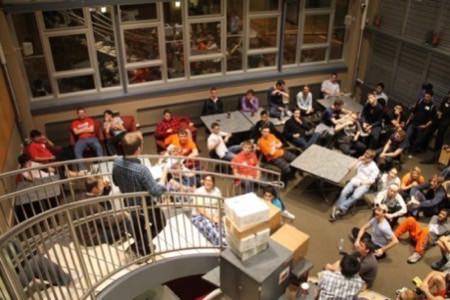
Hinds Hall, Syracuse University campus, 12:27 am ET November 11 – The students in the MLB.com College Challenge are thinking about beginnings. There’s eleven hours left in their project, and that’s still double-digit territory. Their task is to assemble a funding pitch for a group of venture capitalists, who will be portrayed later in the morning by staffers from the MLB.com Web site.
What exactly is square one, anyway? Midnight is a glorious time for a college student’s mind. It’s the moment her parents used to call “way past,” as though barriers had already been broken and the order of the universe upset. If you’re definitely up working at midnight, it’s because you’re in charge and you’re ready to change things.
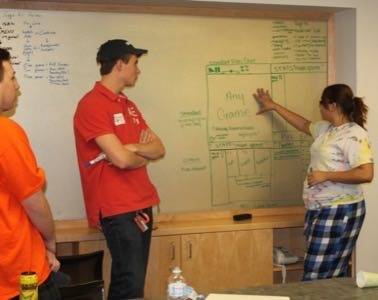
In the conference room for team “Fab 5,” Rachel and Jonathan have annexed the entire whiteboard. They’ve got a Web site worked out in their heads, a complete one-panel rethink of the MLB.TV experience. As Prof. Jeffrey Rubin comes in to check on progress, he watches them and their teammates deliver the prototype of a full sports presentation, complete with lead presenter (Rachel), color commentary (Jonathan), and expert analysis (Bob). Rachel’s a broadcast journalism major, which you can detect by the ease at which she hands off control, and the sense of body placement with respect to the mockup, as though she were presenting an incoming cold front.
The idea is to get the baseball viewer engaged, so that he can see everything that’s going on and connect with everyone else in a broader community who’s doing the same thing. Even from a distance, the magic-marker mockup of the screen layout on the whiteboard looks like a medical diagnosis.
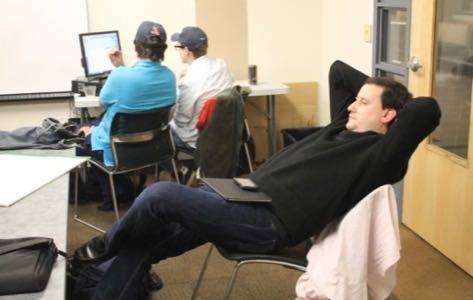
Prof. Rubin is careful not to say too much. He gives guidance but not analysis, because he wants the ideas to come from their heads, not his. “It looks like a lot’s going on,” he says judiciously, like the patron of a new restaurant just given an eight-page menu. He asks a self-probing question, the kind that isn’t so much designed to be answered as to detect how far they’d been thinking about things.
It’s about the panel in Fab 5’s mockup where multiple baseball scores come in from different sources, live. Had the kids thought about the possibility that those scores and stats would be coming in from MLB.com’s competitors in online video? The “yes” answer had a sort of overcooked lasagna-noodle ambiance, like a 14-year-old reassuring Dad she’d done her homework while considering whether or not she had.
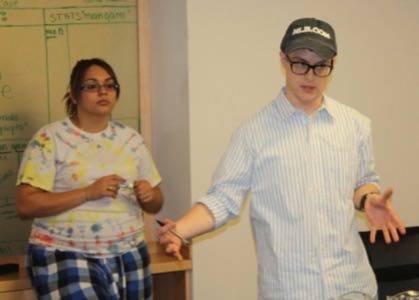
As Rubin took inventory of all the different things to click on, he extracted his iPad and pretended to check some e-mail. Actually, he was boldly making sweeping touch gestures, just enough to get noticed, and perhaps implant a message without having to actually say it.
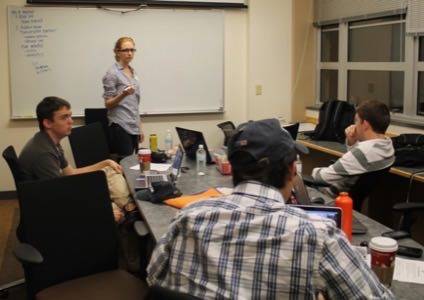
1:07 am “The Saltine Warriors” have their own little practice field in a conference room on the third floor. There’s a management lead – Ariel, a policy studies major – and Terence, a computer science major who’s familiar with the Meetup API. It’s a way to build apps around the Meetup platform, and that’s exactly what this Premium team, if you will, has in mind.
They’ve set out to build a somewhat working (as much a possible) prototype of an app that encourages baseball fans to congregate at a local sports bar for a game, and to communicate through a common platform once they get there. While they’re tossing out ideas, Ariel and Terence are tossing erasers and magic markers, and for a time entertaining their compatriots who are beginning to realize they’ll need any help they can get to stay awake.
Ariel clearly feels more comfortable with a complete outline, and she likes the formal style. Topic I is building out quite nicely, though she’s wary of the emptiness of Topic II. She avoids observing the blank space as though something had been squashed and died there.
Terence, meanwhile, is in his element. He has the FAQ for the Meetup API on one screen, and a JavaScript coding console on another. He’s dispensing ideas with the grace and laid-back attitude of a jazz xylophonist.
Prof. Rubin sits in for a few minutes. They don’t have a complete presentation ready for him yet, and while Ariel is a little worried, Terence couldn’t be any more at ease with himself if there were a reclining comfy chair in the room. The professor tosses out one of his self-probing zingers: You do realize that by marketing to sports bar patrons, you’re limiting your audience to those over 21? It made Ariel’s jaw freeze in position for a minute. It didn’t make Terence skip a beat.

















